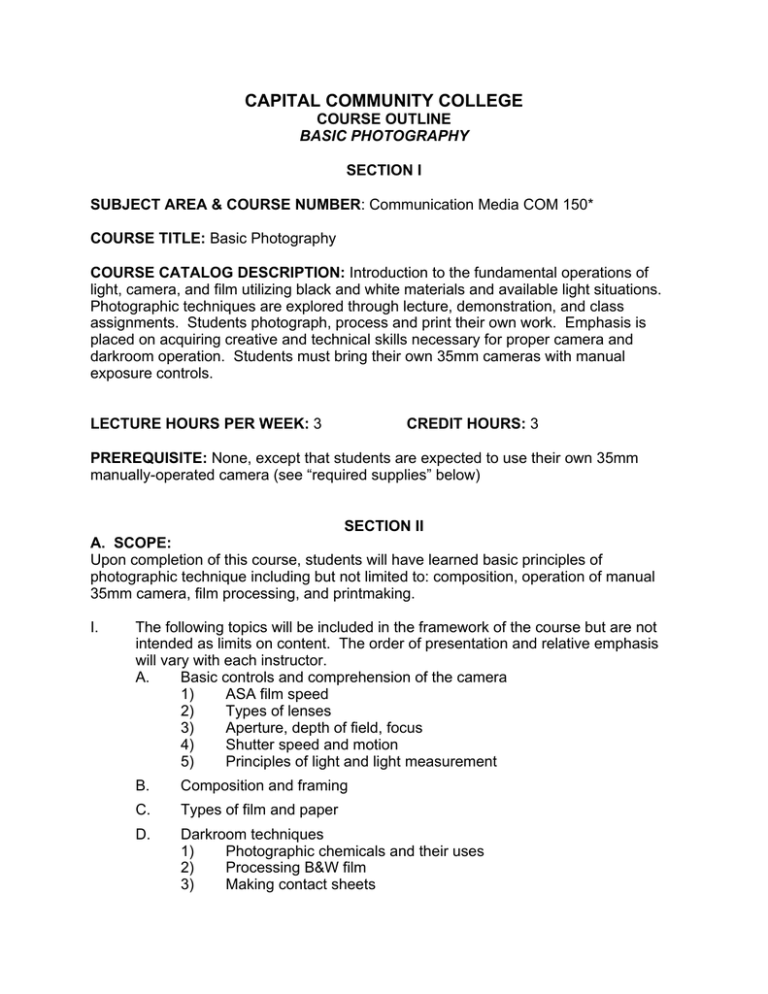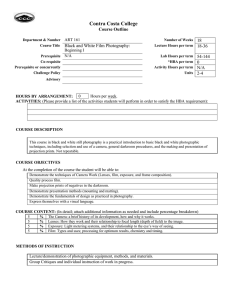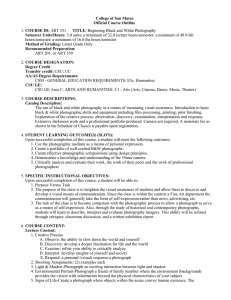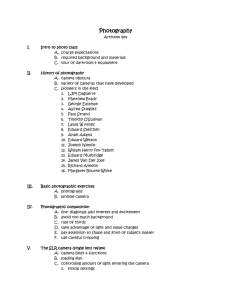150 - Capital Community College
advertisement

CAPITAL COMMUNITY COLLEGE COURSE OUTLINE BASIC PHOTOGRAPHY SECTION I SUBJECT AREA & COURSE NUMBER: Communication Media COM 150* COURSE TITLE: Basic Photography COURSE CATALOG DESCRIPTION: Introduction to the fundamental operations of light, camera, and film utilizing black and white materials and available light situations. Photographic techniques are explored through lecture, demonstration, and class assignments. Students photograph, process and print their own work. Emphasis is placed on acquiring creative and technical skills necessary for proper camera and darkroom operation. Students must bring their own 35mm cameras with manual exposure controls. LECTURE HOURS PER WEEK: 3 CREDIT HOURS: 3 PREREQUISITE: None, except that students are expected to use their own 35mm manually-operated camera (see “required supplies” below) SECTION II A. SCOPE: Upon completion of this course, students will have learned basic principles of photographic technique including but not limited to: composition, operation of manual 35mm camera, film processing, and printmaking. I. The following topics will be included in the framework of the course but are not intended as limits on content. The order of presentation and relative emphasis will vary with each instructor. A. Basic controls and comprehension of the camera 1) ASA film speed 2) Types of lenses 3) Aperture, depth of field, focus 4) Shutter speed and motion 5) Principles of light and light measurement B. Composition and framing C. Types of film and paper D. Darkroom techniques 1) Photographic chemicals and their uses 2) Processing B&W film 3) Making contact sheets 4) 5) Basic use of the enlarger Printing controls: dodging, burning, contrast filters B. REQUIRED WORK: determined by the instructor as described in the course syllabus. 1. READING ASSIGNMENTS Reading assignments focus on acquiring technical vocabulary and reinforcing classroom discussions and hands-on projects. Reading is based from the textbook and current articles from trade journals and newspapers/magazines as provided by the instructor. 2. WRITING ASSIGNMENTS Assignments encourage students to critique their work and that of other students, the instructor, and examples given in class, and to demonstrate acquisition of knowledge in basic photographic techniques. 3. SKILL-RELATED ASSIGNMENTS Students photograph, process, and print their own work within guidelines as given by the instructor. 4. OUTSIDE ASSIGNMENTS Students may be given significant outside assignments, including photography and darkroom laboratory periods outside the scheduled class time. 5. ASSIGNMENTS WHICH DEMONSTRATE CRITICAL THINKING Critical thinking is required of students in both written and hands-on assignments. They learn how to differentiate between “family snapshots” and well-thought, technically correct negatives and prints. In addition, students learn how to critique their work and the work of others. C. ATTENDANCE AND PARTICIPATION: Students are expected to attend each class, arrive on time, take exams at the scheduled time, and participate in the in-class learning process. Attendance of in-class and independent lab time is required. (Specific instructor policies are included on the course syllabus.) D. METHODS OF INSTRUCTION: Methods of instruction must include weekly laboratory time whereby students will be given hands-on instruction and practice with cameras and darkroom equipment. This is balanced with non-laboratory periods, the method of which is determined by each instructor and may include lecture, lecture/discussion, discussion seminar, computer-assisted instruction, audiovisual, required field trips, and any other unique instructional strategies. E. OBJECTIVES, OUTCOMES, ASSESSMENT: Evaluation is based on performance of a variety of activities and assignments, such as in-class and out-of-class writing assignments, projects, quizzes, essay examinations, discussion, and class participation. Attendance is extremely important. 1. 2. 3. 4. 5. 6. Understand the mechanism of the camera in relation to black and white photography. Understand the use of light to control the final image. Understand basic black and white films and papers and their limitations. Learn to process and print black and white film. Learn to make black and white enlargements. Learn aesthetic manipulations in the darkroom to refine a photographic image. To demonstrate an understanding of: Effective usage and mechanics of a 35mm black and white manual SLR camera Students will: a) Read all assigned material from textbooks, handouts, and on-line or Library resources b) Participate in classroom discussions. c) Shoot original photographs to suit purpose. As measured by: Written in-class quizzes, tests, and examinations. The use of light to control a photographic image a) Read all assigned material from textbooks, handouts, and on-line or Library resources b) Participate in classroom discussions and hands-on demonstrations. c) Operate a camera, enlarger, and other darkroom equipment. Submission of media-based projects; written in-class quizzes, tests, and examinations; class participation; attendance; homework assignments. Basic black and white films and papers and their limitations a) Read all assigned material from textbooks, handouts, and on-line or Library resources. b) Use printmaking materials with proficiency and according to purpose. Submission of project materials; class participation; attendance; homework assignments. Black and white film processing a) Read all assigned material from textbooks, handouts, and on-line or Library resources b) Participate in classroom discussions and hands-on workshops The process of making black and white photographic enlargements a) Create, from concept to completion, a series of original black and white photographs. b) Critique classmates’ work in a thoughtful manner. a) Create and process photographic prints using appropriate strategies for revision. b) Critique classmates’ work in a thoughtful manner Written in-class quizzes, tests, and examinations; Submission of computerbased project materials and/or in-class oral presentation Submission of project materials. Aesthetic manipulations used in the darkroom to refine photographic images Use of test strips, printing original photographs, written reports and peer reviews. REQUIRED TECHNOLOGY Black-and-white darkroom equipment, chemistry, and fresh water supply. REQUIRED TEXT & SUPPLIES College level photography texts and workbooks, including technical descriptions of equipment and creative and aesthetic uses of that equipment, are appropriate. Students are expected to use their own manually-operated 35mm camera and purchase all consumable supplies except photo chemistry. Revised 6/06



